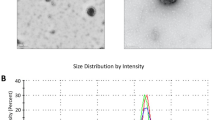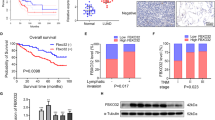Abstract
The metastatic cascade is a complex and multistep process with many potential barriers. Recent evidence has shown that microRNAs (miRNAs) are involved in carcinogenesis and tumor progression in non-small-cell lung cancer (NSCLC). In this study, by comparing the miRNA expression profiles of SPC-A-1sci (high metastatic) and SPC-A-1 (weakly metastatic) cells, we demonstrated that the downregulation and function of miR-193a-3p and miR-193a-5p in NSCLC metastasis and the expression of these miRNAs was suppressed in NSCLC compared with corresponding non-tumorous tissues. Decreased miR-193a-3p/5p expression was significantly associated with tumor node metastasis (TNM) and lymph node metastasis. Furthermore, functional assays showed that the overexpression of miR-193a-3p/5p inhibited NSCLC cell migration, invasion and epithelial–mesenchymal transition (EMT) in vitro and lung metastasis formation in vivo. In addition, we discovered that ERBB4 and S6K2 were the direct targets of miR-193a-3p and that PIK3R3 and mTOR were the direct targets of miR-193a-5p in NSCLC. We also observed that miR-193a-3p/5p could inactivate the AKT/mTOR signaling pathway. Thus, miR-193a-3p/5p functions as a tumor suppressor and has an important role in NSCLC metastasis through ERBB signaling pathway.
This is a preview of subscription content, access via your institution
Access options
Subscribe to this journal
Receive 50 print issues and online access
$259.00 per year
only $5.18 per issue
Buy this article
- Purchase on Springer Link
- Instant access to full article PDF
Prices may be subject to local taxes which are calculated during checkout






Similar content being viewed by others
References
Jemal A, Bray F, Center MM, Ferlay J, Ward E, Forman D . Global cancer statistics. Cancer J Clin 2011; 61: 69–90.
Sharieff W, Okawara G, Tsakiridis T, Wright J . Predicting 2-year survival for radiation regimens in advanced non-small cell lung cancer. Clin Oncol 2013; 25: 697–705.
Heist RS, Engelman JA . SnapShot: non-small cell lung cancer. Cancer Cell 2012; 21: 448.
Yang X, Zhang Z, Qiu M, Hu J, Fan X, Wang J et al. Glypican-5 is a novel metastasis suppressor gene in non-small cell lung cancer. Cancer Lett 2013; 341: 265–273.
Ambros V . The functions of animal microRNAs. Nature 2004; 431: 350–355.
Bartel DP . MicroRNAs: genomics, biogenesis, mechanism, and function. Cell 2004; 116: 281–297.
Bartel DP . MicroRNAs: target recognition and regulatory functions. Cell 2009; 136: 215–233.
Lewis BP, Burge CB, Bartel DP . Conserved seed pairing, often flanked by adenosines, indicates that thousands of human genes are microRNA targets. Cell 2005; 120: 15–20.
Calin GA, Croce CM . MicroRNA signatures in human cancers. Nat Rev Cancer 2006; 6: 857–866.
Almeida MI, Reis RM, Calin GA . MicroRNA history: discovery, recent applications, and next frontiers. Mutat Res 2011; 717: 1–8.
Calin GA, Croce CM . MicroRNA–cancer connection: the beginning of a new tale. Cancer Res 2006; 66: 7390–7394.
Minami A, Shimono Y, Mizutani K, Nobutani K, Momose K, Azuma T et al. Reduction of the ST6 beta-galactosamide alpha-2,6-sialyltransferase 1 (ST6GAL1)-catalyzed sialylation of nectin-like molecule 2/cell adhesion molecule 1 and enhancement of ErbB2/ErbB3 signaling by microRNA-199a. J Biol Chem 2013; 288: 11845–11853.
Feng B, Dong TT, Wang LL, Zhou HM, Zhao HC, Dong F et al. Colorectal cancer migration and invasion initiated by microRNA-106a. PLoS One 2012; 7: e43452.
Goldberger N, Walker RC, Kim CH, Winter S, Hunter KW . Inherited variation in miR-290 expression suppresses breast cancer progression by targeting the metastasis susceptibility gene Arid4b. Cancer Res 2013; 73: 2671–2681.
Yang H, Fang F, Chang R, Yang L . MicroRNA-140-5p suppresses tumor growth and metastasis by targeting transforming growth factor beta receptor 1 and fibroblast growth factor 9 in hepatocellular carcinoma. Hepatology 2013; 58: 205–217.
Zheng B, Liang L, Wang C, Huang S, Cao X, Zha R et al. MicroRNA-148a suppresses tumor cell invasion and metastasis by downregulating ROCK1 in gastric cancer. Clin Cancer Res 2011; 17: 7574–7583.
Lin CW, Chang YL, Chang YC, Lin JC, Chen CC, Pan SH et al. MicroRNA-135b promotes lung cancer metastasis by regulating multiple targets in the Hippo pathway and LZTS1. Nat Commun 2013; 4: 1877.
Meng W, Ye Z, Cui R, Perry J, Dedousi-Huebner V, Huebner A et al. MicroRNA-31 predicts the presence of lymph node metastases and survival in lung adenocarcinoma patients. Clin Cancer Res 2013; 19: 5423–5433.
Wu X, Liu T, Fang O, Leach LJ, Hu X, Luo Z . miR-194 suppresses metastasis of non-small cell lung cancer through regulating expression of BMP1 and p27kip1. Oncogene (e-pub ahead of print 15 April 2013; doi:10.1038/onc.2013.108).
Jia D, Yan M, Wang X, Hao X, Liang L, Liu L et al. Development of a highly metastatic model that reveals a crucial role of fibronectin in lung cancer cell migration and invasion. BMC Cancer 2010; 10: 364.
Lin HC, Zhang FL, Geng Q, Yu T, Cui YQ, Liu XH et al. Quantitative proteomic analysis identifies CPNE3 as a novel metastasis-promoting gene in NSCLC. J Proteome Res 2013; 12: 3423–3433.
Almeida MI, Nicoloso MS, Zeng L, Ivan C, Spizzo R, Gafa R et al. Strand-specific miR-28-5p and miR-28-3p have distinct effects in colorectal cancer cells. Gastroenterology 2012; 142: 886–896.
Heller G, Weinzierl M, Noll C, Babinsky V, Ziegler B, Altenberger C et al. Genome-wide miRNA expression profiling identifies miR-9-3 and miR-193a as targets for DNA methylation in non-small cell lung cancers. Clin Cancer Res 2012; 18: 1619–1629.
Yang Y, Zhou L, Lu L, Wang L, Li X, Jiang P et al. A novel miR-193a-5p-YY1-APC regulatory axis in human endometrioid endometrial adenocarcinoma. Oncogene 2013; 32: 3432–3442.
Tao ZH, Wan JL, Zeng LY, Xie L, Sun HC, Qin LX et al. miR-612 suppresses the invasive-metastatic cascade in hepatocellular carcinoma. J Exp Med 2013; 210: 789–803.
Xu L, Wen Z, Zhou Y, Liu Z, Li Q, Fei G et al. MicroRNA-7-regulated TLR9 signaling-enhanced growth and metastatic potential of human lung cancer cells by altering the phosphoinositide-3-kinase, regulatory subunit 3/Akt pathway. Mol Biol Cell 2013; 24: 42–55.
Iliopoulos D, Rotem A, Struhl K . Inhibition of miR-193a expression by Max and RXRalpha activates K-Ras and PLAU to mediate distinct aspects of cellular transformation. Cancer Res 2011; 71: 5144–5153.
Farazi TA, Spitzer JI, Morozov P, Tuschl T . miRNAs in human cancer. J Pathol 2011; 223: 102–115.
Uhlmann S, Mannsperger H, Zhang JD, Horvat EA, Schmidt C, Kublbeck M et al. Global microRNA level regulation of EGFR-driven cell-cycle protein network in breast cancer. Mol Syst Biol 2012; 8: 570.
Hu H, Li S, Liu J, Ni B . MicroRNA-193b modulates proliferation, migration, and invasion of non-small cell lung cancer cells. Acta Biochim Biophys Sin 2012; 44: 424–430.
Polyak K, Weinberg RA . Transitions between epithelial and mesenchymal states: acquisition of malignant and stem cell traits. Nat Rev Cancer 2009; 9: 265–273.
Trask MC, Tremblay KD, Mager J . Yin-Yang1 is required for epithelial-to-mesenchymal transition and regulation of Nodal signaling during mammalian gastrulation. Dev Biol 2012; 368: 273–282.
Imbert AM, Garulli C, Choquet E, Koubi M, Aurrand-Lions M, Chabannon C . CD146 expression in human breast cancer cell lines induces phenotypic and functional changes observed in epithelial to mesenchymal transition. PLoS One 2012; 7: e43752.
Gulhati P, Bowen KA, Liu J, Stevens PD, Rychahou PG, Chen M et al. mTORC1 and mTORC2 regulate EMT, motility, and metastasis of colorectal cancer via RhoA and Rac1 signaling pathways. Cancer Res 2011; 71: 3246–3256.
Mendoza-Naranjo A, El-Naggar A, Wai DH, Mistry P, Lazic N, Ayala FR et al. ERBB4 confers metastatic capacity in Ewing sarcoma. EMBO Mol Med 2013; 5: 1019–1034.
Muraoka-Cook RS, Sandahl M, Hunter D, Miraglia L, Earp HS III . Prolactin and ErbB4/HER4 signaling interact via Janus kinase 2 to induce mammary epithelial cell gene expression differentiation. Mol Endocrinol (Baltimore, MD) 2008; 22: 2307–2321.
Sridharan S, Basu A . S6 kinase 2 promotes breast cancer cell survival via Akt. Cancer Res 2011; 71: 2590–2599.
Wander SA, Zhao D, Besser AH, Hong F, Wei J, Ince TA et al. PI3K/mTOR inhibition can impair tumor invasion and metastasis in vivo despite a lack of antiproliferative action in vitro: implications for targeted therapy. Breast Cancer Res Treat 2013; 138: 369–381.
Starr A, Greif J, Vexler A, Ashkenazy-Voghera M, Gladesh V, Rubin C et al. ErbB4 increases the proliferation potential of human lung cancer cells and its blockage can be used as a target for anti-cancer therapy. Int J Cancer 2006; 119: 269–274.
Hegde GV, de la Cruz CC, Chiu C, Alag N, Schaefer G, Crocker L et al. Blocking NRG1 and other ligand-mediated Her4 signaling enhances the magnitude and duration of the chemotherapeutic response of non-small cell lung cancer. Sci Transl Med 2013; 5: 171ra18, 1–11.
Lai WW, Chen FF, Wu MH, Chow NH, Su WC, Ma MC et al. Immunohistochemical analysis of epidermal growth factor receptor family members in stage I non-small cell lung cancer. Ann Thorac Surg 2001; 72: 1868–1876.
Sasaki H, Okuda K, Kawano O, Endo K, Yukiue H, Yokoyama T et al. ErbB4 expression and mutation in Japanese patients with lung cancer. Clin Lung Cancer 2007; 8: 429–433.
Tomizawa K, Suda K, Onozato R, Kuwano H, Yatabe Y, Mitsudomi T . Analysis of ERBB4 mutations and expression in Japanese patients with lung cancer. J Thorac Oncol 2010; 5: 1859–1861.
Li Y, Gao L, Luo X, Wang L, Gao X, Wang W et al. Epigenetic silencing of microRNA-193a contributes to leukemogenesis in t(8;21) acute myeloid leukemia by activating the PTEN/PI3K signal pathway. Blood 2013; 121: 499–509.
Acknowledgements
This work was supported by Shanghai Science and Technology Developing Program (12140901500, 13140900502). We thank Deshui Jia and QiangTan for the kind suggestions and technical assistance.
Author information
Authors and Affiliations
Corresponding author
Ethics declarations
Competing interests
The authors declare no conflict of interest.
Additional information
Supplementary Information accompanies this paper on the Oncogene website
Rights and permissions
About this article
Cite this article
Yu, T., Li, J., Yan, M. et al. MicroRNA-193a-3p and -5p suppress the metastasis of human non-small-cell lung cancer by downregulating the ERBB4/PIK3R3/mTOR/S6K2 signaling pathway. Oncogene 34, 413–423 (2015). https://doi.org/10.1038/onc.2013.574
Received:
Revised:
Accepted:
Published:
Issue Date:
DOI: https://doi.org/10.1038/onc.2013.574
Keywords
This article is cited by
-
Correlation between large rearrangements and patient phenotypes in NF1 deletion syndrome: an update and review
BMC Medical Genomics (2024)
-
Sex differences in the tumor promoting effects of tobacco smoke in a cRaf transgenic lung cancer disease model
Archives of Toxicology (2024)
-
Changes in miRNA expression in the lungs of pigs supplemented with different levels and forms of vitamin D
Molecular Biology Reports (2024)
-
The dynamic alteration of transcriptional regulation by crucial TFs during tumorigenesis of gastric cancer
Molecular Medicine (2022)
-
Identification of targetable kinases in idiopathic pulmonary fibrosis
Respiratory Research (2022)



